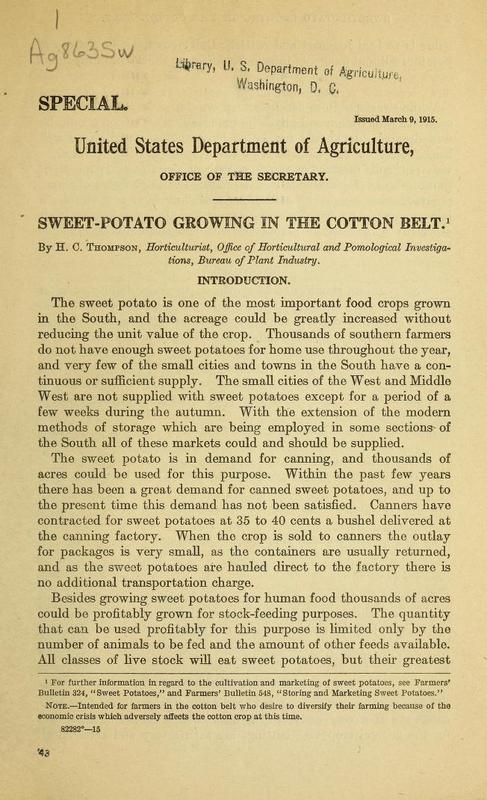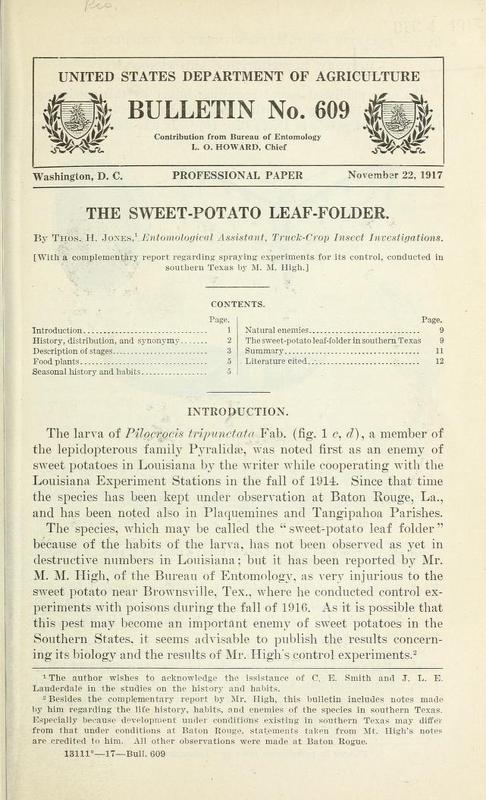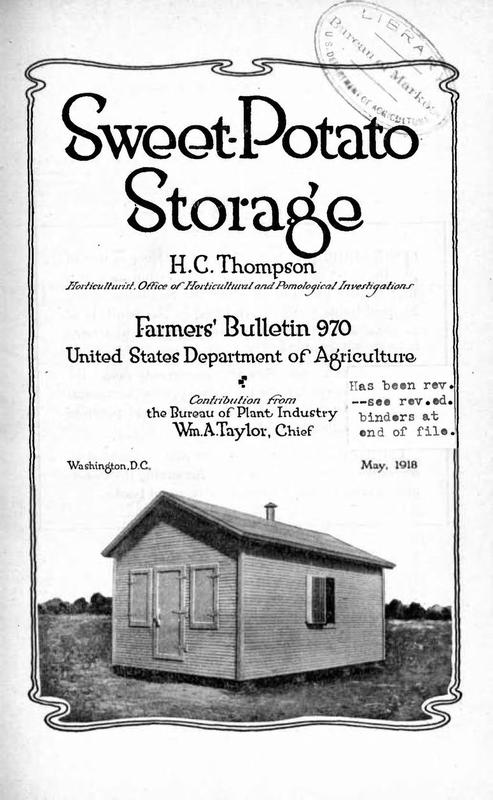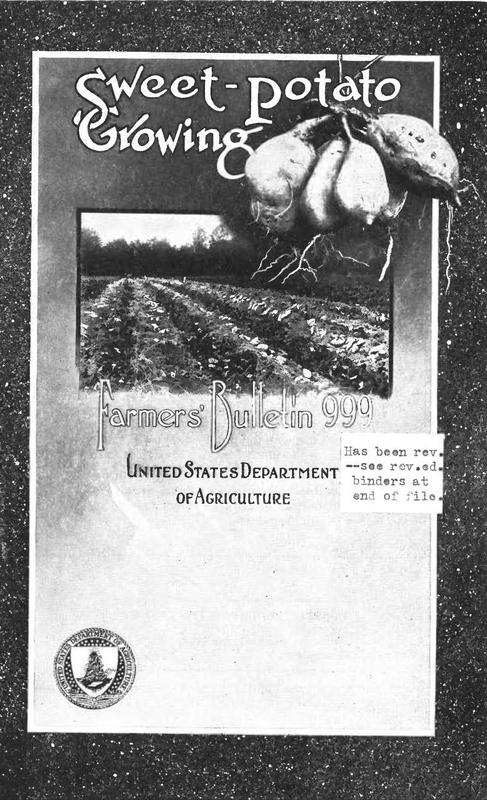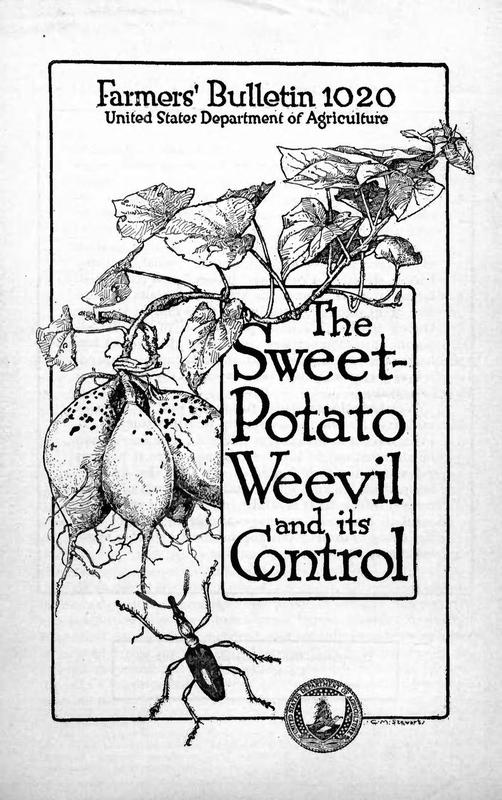Sweet Potatoes as a Crop
The colored farmers of Macon County alone ought to produce annually 1,000,000 bushels of sweet potatoes in addition to their cotton crops. A sweet potato is something that can always be used. It can be used to feed cows, pigs and chickens. Aside from this, there is always sale for sweet potatoes. There is no better climate or soil in the world for producing sweet potatoes than we have right here in Macon County, and there is no reason why any farmer even though his cotton crop fails, should not be in good condition by reason of having planted sweet potatoes to eat and sell. Let us all unite in making Macon County the banner sweet potato producing county throughout the entire South.
Carver, George Washington (1910). Possibilities of the Sweet Potato in Macon County, Alabama. Tuskegee Normal and Industrial Institute. Tuskegee Institute. Agricultural Experiment Station Bulletin Number 17, p. 3.
(Click any image in this exhibit to get more information, including access to full text)
"If there is one crop more than another, that Macon County can produce year by year and with almost unerring certainty, it is the sweet potato crop.
Now what is true of Macon County is true of the adjoining counties, and is more or less true of the entire South.
HISTORY
It is said that the early navigators of the sixteenth century recognized such a strong resemblance between the Irish potato and the sweet potato that they called them both by the same name.
They are not only different botanically, but the edible parts of each are in character and taste quite unlike.
Botanically, the sweet potato belongs to the morning glory family (Convolvulaceae), and has been given the technical name of Ipome abatatas.
ORIGIN
The origin of the sweet potato is doubtful, although there is very strong evidence that it is distinctly American, as fifteen or sixteen known species of the genus Batatas are found in this country. The ‘Indian potato,’ ‘Tuckahoe’ and ‘Hog potato,’' which grow abundantly in this country and throughout the South, are all species of this genus.
VARIETIES
More than 100 so-called varieties make up the present list, many of which there is a distinction without a well-defined difference.
Since some varieties do well in one section and practically fail in others, I have thought wise to list none except those that have proven the most prolific and best with us.
TABLE VARIETIES: Dooley Yam, Improved Dooley Yam, Triumph and Pumpkin Yam.
VARIETIES FOR FEEDING STOCK: These grow to a very large size and make a fine yield, but are not very sweet and rather inferior for table use— White Bermuda, Red Nansemond, ‘Negro Choker’ and Hayti Spanish."
"In summing up and drawing conclusions from this experiment, I think it quite safe to conclude that, with the proper management, 500 bushels of sweet potatoes can be produced on one acre of our ordinary potato soils ; since 266 bushels were produced under the following trying conditions:
First — Abnormally poor soil, physically, mechanically and chemically.
Second — Owing to unavoidable reasons, the fertilizers could not be applied at the right time, which decreased the yield.
Third — The plants were set quite three weeks late.
Fourth — The potato crop was practically a failure almost all over the entire South; the average yield in this section being about 87 bushels per acre."
The U.S. Department of Agriculture has a long history of creating materials helpful to the small farmer for the development of specific crops such as sweet potatoes. Here is a sample of documents published around the time of Carver's bulletins:
"The sweet potato is one of the most important food crops grown in the South, and the acreage could be greatly increased without reducing the unit value of the crop. Thousands of southern farmers do not have enough sweet potatoes for home use throughout the year, and very few of the small cities and towns in the South have a continuous or sufficient supply. The small cities of the West and Middle West are not supplied with sweet potatoes except for a period of a few weeks during the autumn. With the extension of the modern methods of storage which are being employed in some sections of the South all of these markets could and should be supplied.
The sweet potato is in demand for canning, and thousands of acres could be used for this purpose. Within the past few years there has been a great demand for canned sweet potatoes, and up to the present time this demand has not been satisfied. Canners have contracted for sweet potatoes at 35 to 40 cents a bushel delivered at the canning factory. When the crop is sold to canners the outlay for packages is very small, as the containers are usually returned, and as the sweet potatoes are hauled direct to the factory there is no additional transportation charge.
Besides growing sweet potatoes for human food thousands of acres could be profitably grown for stock-feeding purposes. The quantity that can be used profitably for this purpose is limited only by the number of animals to be fed and the amount of other feeds available. All classes of live stock will eat sweet potatoes, but their greatest value is as feed for hogs and cattle. Dairy cows can be fed sweet potatoes without danger of injuriously affecting the flavor of the milk."
"The larva of Pilocrocis tripunctata Fab. (fig. 1 c, d), a member of the lepidopterous family Pyralidae, was noted first as an enemy of sweet potatoes in Louisiana by the writer while cooperating with the Louisiana Experiment Stations in the fall of 1914. Since that time the species has been kept under observation at Baton Rouge, La., and has been noted also in Plaquemines and Tangipahoa Parishes. The species, which may be called the "sweet-potato leaf folder" because of the habits of the larva, has not been observed as yet in destructive numbers in Louisiana: but it has been reported by Mr. M. M. High, of the Bureau of Entomology, as very injurious to the sweet potato near Brownsville, Tex., where he conducted control experiments with poisons during the fall of 1916. As it is possible that this pest may become an important enemy of sweet potatoes in the Southern States, it seems advisable to publish the results concerning its biology and the results of Mr. High's control experiments."
"The proper storage of sweet potatoes is one of the most important food conservation measures that can be put into effect in the Southern States. No perishable product produced in the South is of as great importance as the sweet potato, and none is so poorly handled.
This bulletin describes in considerable detail the types of storage houses that have proved successful and the proper method of handling sweet potatoes from harvesting to marketing.
For those growers who are not able to build storage houses, directions are given for saving the sweet potato crop by using outdoor cellars and banks."
"A sufficient quantity of sweet potatoes for home use can be grown under a wide range of conditions, but when the crop is to be produced commercially the soil, climate, and market should be carefully considered.
Sweet potatoes work in well with a rotation of farm or truck crops, and if improved methods of growing and storing the crop are employed good returns are realized.
The sweet potato is propagated by plants or slips and by vine cuttings. The plants are produced by sprouting the seed potatoes in warm sand. The cuttings are made in the field after the plants begin to vine.
When bottom heat is necessary for growing the plants, the hotbed can be heated with manure, by flues, or by steam or hot-water pipes. In the South, where no bottom heat is necessary, the plants are grown in coldframes.
The success of the crop in the field will depend largely upon the way the plants start off after being removed from the plant bed and set in the field or garden.
Sweet potatoes should be harvested carefully and graded and packed in attractive packages in order to insure profitable returns."
"Immense lossess of sweet potatoes in the Gulf States are being caused by the sweet-potato weevil. This foreign pest, introduced into the United States years ago, has become very destructive recently and now threatens to invade all States in which sweet potatoes are grown.
The slender, metallie-blue weevil, about a quarter of an inch long with red legs and "waist," attaeks leaves, stems, and roots or "tubers," and its whitish larva; or grubs tunnel the stalks and roots and inflict great damage, both in the field and in storage. Owing to the increased production of the sweet potato crop to meet war conditions, this weevil has become a pest of the greatest importance. Indeed, it is to the sweet-potato industry what the boll weevil is to cotton.
This bulletin describes the insect and its injuries and gives a sufficient account of its life history to explain the control measures advised. The weevil can be stamped out in limited regions where it has not yet secured a firm foothold, and then, by quarantines, it can be kept out of States and parts of States not yet infested. It is vitally important at present to combat, by every means available, an insect that threatens to destroy our second most valuable vegetable crop."
"Only two distinctly starchy vegetables, the potato and the sweet potato, are commonly grown in the United States. A fall-maturing crop of the same character— the dasheen— was introduced a number of years ago for cultivation in the Southern States, primarily to supplement the small supply of home-grown potatoes. Most of the potatoes used in the far South are shipped from the North, and a part of this need might well be met by dasheens locallv grown.
The foreign populations of our larger eities formerly used considerable quantities of dasheens and related vegetables imported from the Orient and the West Indies. This market is now supplied largely by dasheens grown in the Southern States.
Dasheens are used generally for home consumption by hundreds of growers and to a small extent by native Americans in a number of cities. Conservatism in food habits and the frequent marketing of dasheens of unattractive appearance or inferior quality have prevented a more rapid growth of the market demand. Continuous effort by growers and others in the South to make the excellence of this vegetable known to winter tourists and care in marketing only the best dasheens are calculated to bring about a largely increased demand."
"Eleven Southern States produce sugary, moist-fleshed sweet potatoes so unlike the dry, mealy varieties shipped from the northeastern section of the producing area that they are recognized as a distinct class or type on the principal markets of the United States. For many years the sweet potato has been the most important vegetable crop in the South, but only in recent years have southern growers and shippers undertaken to market an appreciable amount of the crop outside of the producing areas, especially in the large cities of the North and East.
They have succeeded in distributing southern sweet potatoes* in practically all of the important car-lot markets of the country, but they have experienced many difficulties. The moist-fleshed varieties produced in this group of States are no more peculiar to the territory than are the marketing problems of southern growers and shippers. Many of them have overestimated the demand for their product and underestimated the need for economical production and better marketing practices."
"Diseases of sweet potatoes are divisible into two classes, (1) field troubles and (2) storage rots. Field troubles are divisible into root and stem diseases and leaf diseases.
Root and stem diseases include stem rot, black rot, foot rot, scurf, root rot, mottle necrosis, and soil rot; and leaf diseases include leaf blight, white rust, and leaf spot. For the control of the three diseases first mentioned, seed selection, the use of clean seed beds, disinfection of the seed potatoes before bedding, and crop rotations are about all that can be recommended, since the fungi causing the diseases invade the interior and make the use of fungicides futile.
Scurf is best controlled by the selection of clean seed and by disinfecting the seed potatoes for 8 minutes in a solution of mercuric chloride (1 ounce to 8 gallons of water).
Root rot is particularly difficult to control. Deep, clean cultivation, aeration of the soil, and crop rotation, together with the careful selection of disease-free potatoes for seed, are important aids.
Leaf blight, leaf spot, and white rust have never been serious enough to require remedial measures.
Control of the five storage rots described hinges on careful storage-house management.
Sweet potatoes infected with field diseases should never be placed in storage, for heavy loss will follow. But this elimination of field diseases must be coupled with a well-regulated system of storage, the first requisite of which is a thoroughly disinfected house free from the numerous storage-rot germs."
 An official website of the United States government.
An official website of the United States government.




